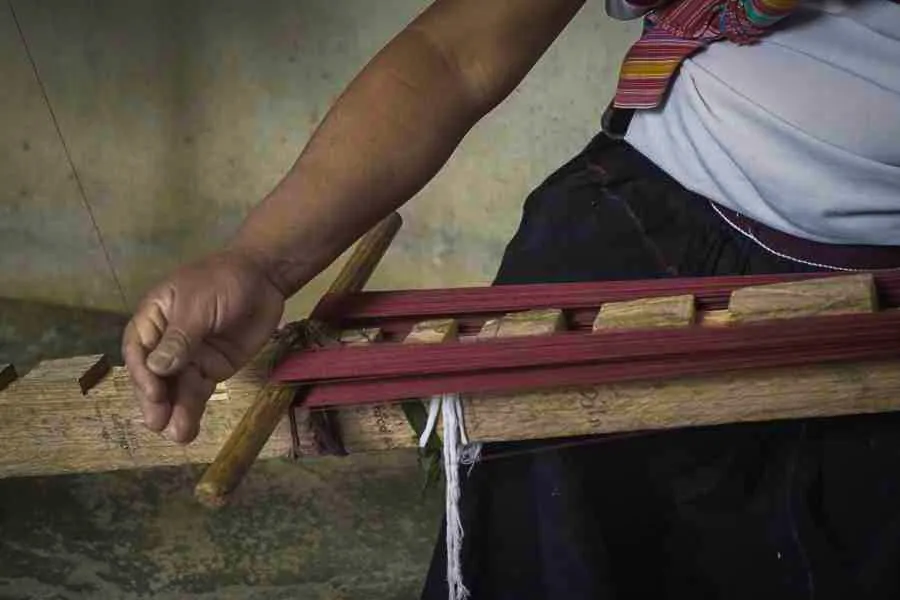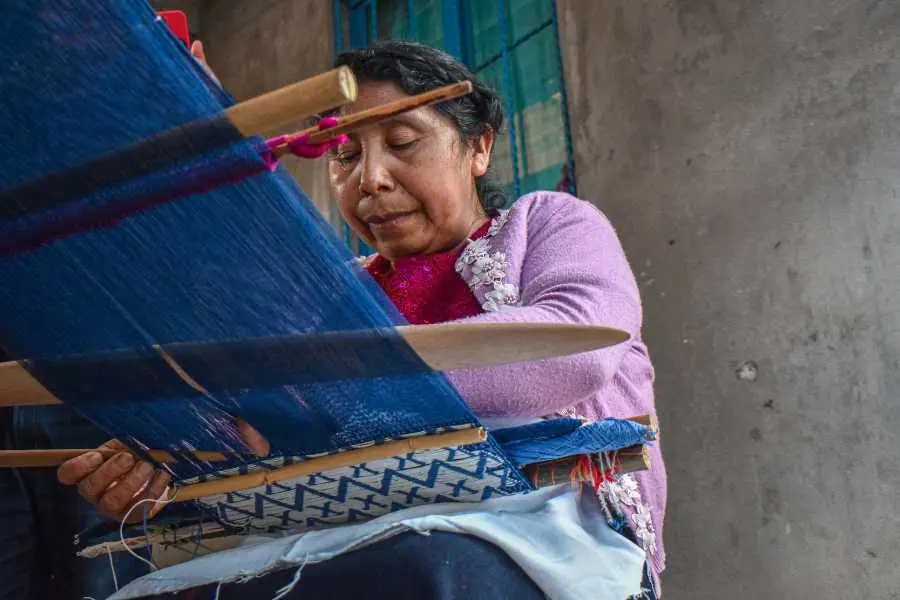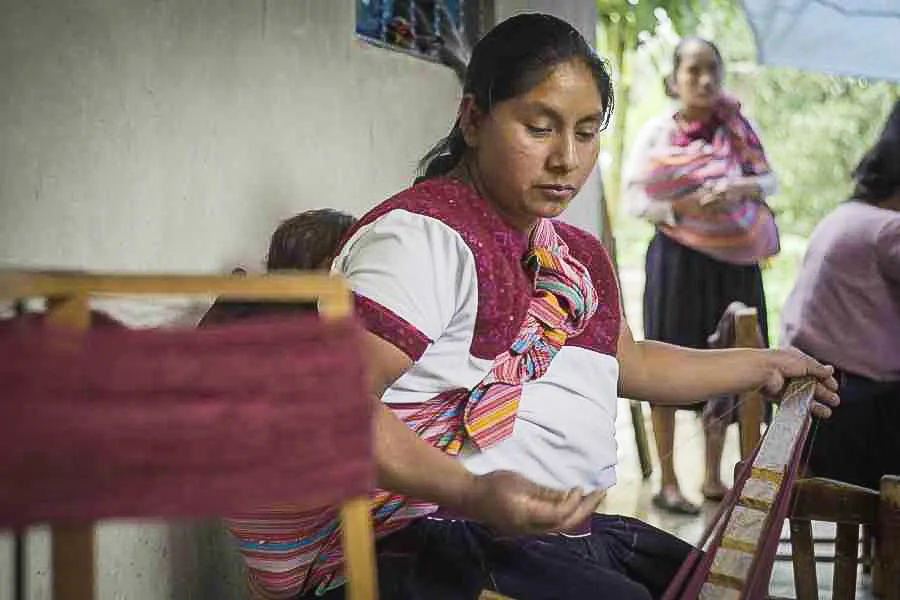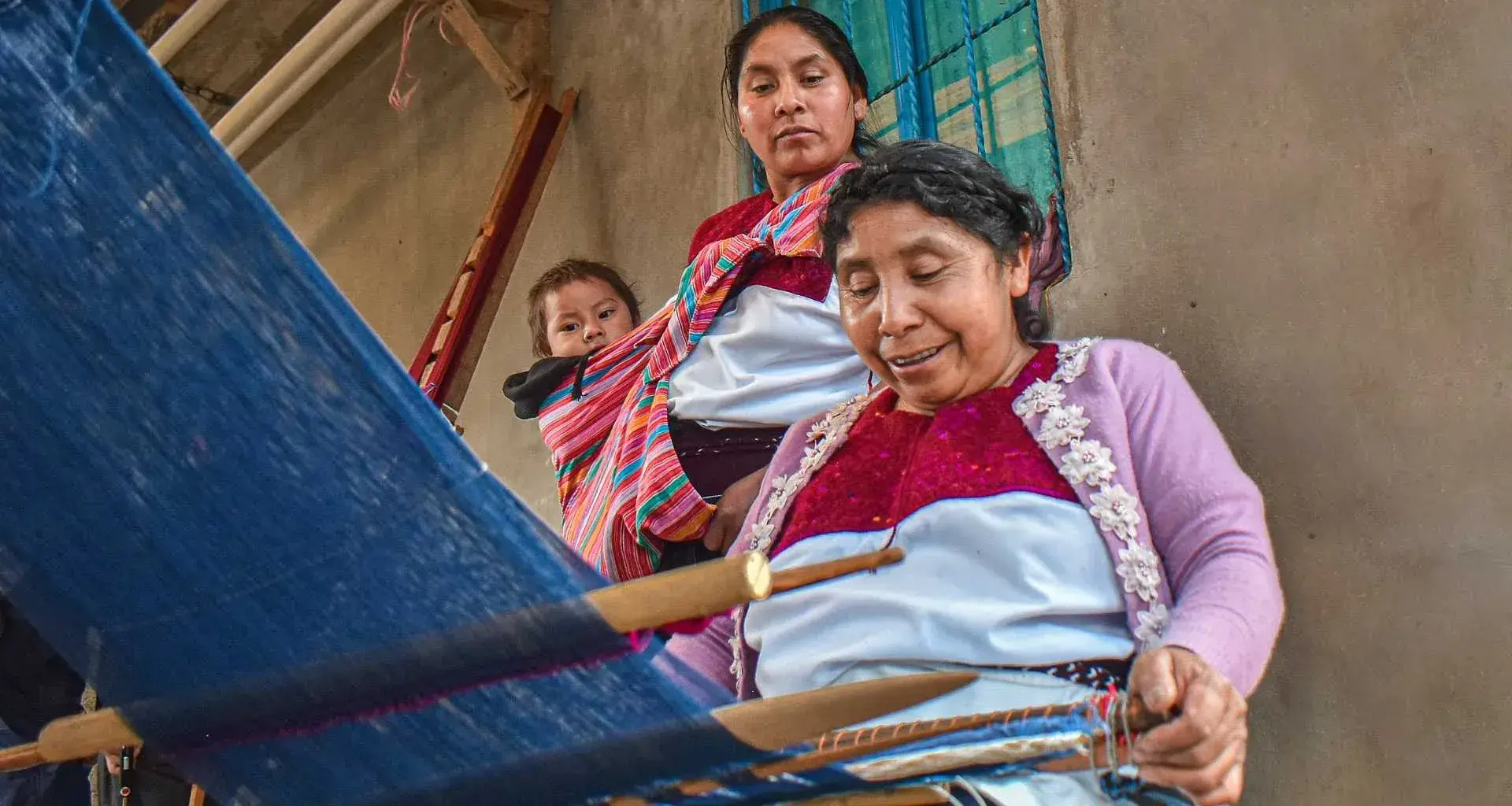Rosa’s hands move rhythmically as she intertwines and tightens hundreds of threads that run from a pole in her house to her waist. The technique she uses has been passed down from generation to generation by her people: the Maya.
Each thread of their embroidery tells the story of who they were and who they are now.
Rosa learned to use a backstrap loom at the age of 12, thanks to her mother Andrea. She says that the most difficult thing about this art is creating the “Holy Mother” figure.
This is a symbol that uses geometric shapes to form a female figure associated with the Moon and the Virgin Mary.
It is also the figure used as a logo by Sluch Metik, a textile company created by artisans from San Andrés Larráinzar, Chiapas, which is working with Tec de Monterrey’s Center for Social Innovation (CIS for its initials in Spanish).

The sacred art of weaving
According to statistics from the Chiapas Institute of Handicrafts, 60% of the artisans in Chiapas are women, and most of them learn between the ages of 10 and 12.
It then takes them about two years to master the technique. They are trained by their mothers, grandmothers, or other more experienced women in their community.
The secret of the technique has been carefully guarded by each generation and is practiced just as the ancient Mayans did (with improvements in some cases).
In fact, some families have very old sample books and only dye their threads with plant extracts from their region.
The result represents their culture, fauna, flora, and beliefs. Each element has a meaning, and the weaving process could take days or years depending on the garment.
For example, a small garment such as a shawl takes 15 days to make, while a more detailed garment such as a traditional Huipil, could take from five months to one year.
All this has garnered the art of the weavers from San Andrés Larráinzar worldwide recognition for its beauty and tradition. However, it is poorly paid.

The professionalization of artisans
Most of the artisans are faced with people “haggling” for their products. For example, people refuse to pay a fair price because they compare the price with Chinese copies.
What’s more, most of the weavers don’t speak Spanish, as their mother tongue is Tzotzil and Tzeltal. According to México's goverment, there are 1,459,648 people in Chiapas who speak an indigenous language.
For every 100 people who speak an indigenous language, 12 don’t speak Spanish. They don’t use social media either.
“We want fair pay for our work and that’s why we’ve come together,” explains Rosa.
It was at this point that Tec de Monterrey students joined the fray, through the Center for Social Innovation (CIS).
CIS aims to connect national and foreign students and universities who are willing to work together on social entrepreneurship projects. It was inaugurated on October 26, 2018, in San Cristóbal de las Casas, Chiapas.
The artisans became training partners for the students, allowing them to learn about their problems and day-to-day lives.
A training partner is a person or agency from the manufacturing or service sector, government, civil society, or community groups with whom the Tec establishes a long-term collaborative relationship through the Tec21 Model, which is based on learning based on challenges.
In this experience, the CIS apprentices developed ideas to add to the weavers’ established projects.
“All innovation is validated by the community,” says Martha Velázquez, Director of CIS. “Our students understand that we’re not just helping, but we’re joining, collaborating, and learning from the communities.”
The result was a strategy to improve the skills of the artisans in brand promotion, distribution channels, finance, and models.
This is how Sluch Metik was created, which is a textile company with identity, sales channels, and artisans with knowledge of finance.
Something distinctive about the brand is that it manufactures traditional products but has adapted to current needs.
In addition to traditional products, they make laptop bags, caps, and other accessories with sales potential.

Living pieces of Mayan heritage
The collective of artisans from Sluch Metik have their own physical product store in one of the rooms of their house.
On a long wooden table, they display bags, purses, bracelets, laptop bags, caps, cushion covers, and key rings.
The largest items are displayed on the walls, such as table runners, bed runners, blouses, dresses, and waistbands.
In the middle of this Mayan art exhibition, Rosa points out the symbols in each garment.
The most complex embroidery pattern is the “Holy Mother,” a female silhouette formed of geometric shapes.
They associate it with the pre-Hispanic goddess of the Moon. This goddess is the one who, according to Mayan mythology, taught women the art of the backstrap loom. It is now also associated with the Virgin Mary.
There is also an embroidery pattern that represents their ancestors: “The Toad.” For Rosa’s people, the presence of these amphibians means that the land is fertile and that their harvest will be good.
That’s why the streets of San Andrés Larráinzar are adorned with this image.
Another important pattern in the looms is the “Father and Mother,” a complex composition of two human figures that merge to represent family.
This embroidery pattern is made up of a woman on the left and a man on the right.
The female figure has four arms, representing the multiple activities that women can perform during the day.
And the male figure is depicted with his arms raised as if holding up his family, says Rosa.
But both figures merge at the bottom, “because they’re one and the same,” says Rosa.
The artisans also like to draw what they see in their community. Their products are a catalog of the region’s flowers.
The rhombus is a geometric shape that predominates in their embroideries and that forms other more complex silhouettes, but by itself, it represents the cardinal points and time.
Each piece of art opens a window onto the Mayan past and is also a book where the days, years, important festivals, and cardinal points are written. But, more importantly, it depicts the dreams and struggles of the female weavers.
About the first Indigenous Knowledge Workshop
This encounter with the weavers was part of an immersive experience at the First Indigenous Knowledge Workshop of the Association of Pacific Rim Universities (APRU) organized by Tec de Monterrey and the University of Melbourne.
The event was held in Chiapas from November 1 to 5, at Tec de Monterrey’s Center for Social Innovation (CIS), as well as the institution’s Center for the Recognition of Human Dignity.
“This event is extremely important for the Tec because we are both diverse countries with enormous cultural wealth. We must recognize, appreciate, and show the richness of our culture as it is now and can still be in the future,” said Inés Sáenz, Vice President of Social Inclusion, Impact, and Sustainability.
During the experience, representatives from Ecuador, the Philippines, Australia, New Zealand, Canada, the United States, and Mexico shared best practices that researchers have seen for language preservation, education, cultural diversity, and indigenous identity.
The delegation had the opportunity to meet the backstrap loom artisans from San Andrés Larráinzar, eat with them, observe the process of making garments, admire their products, and buy them.
READ MORE:





